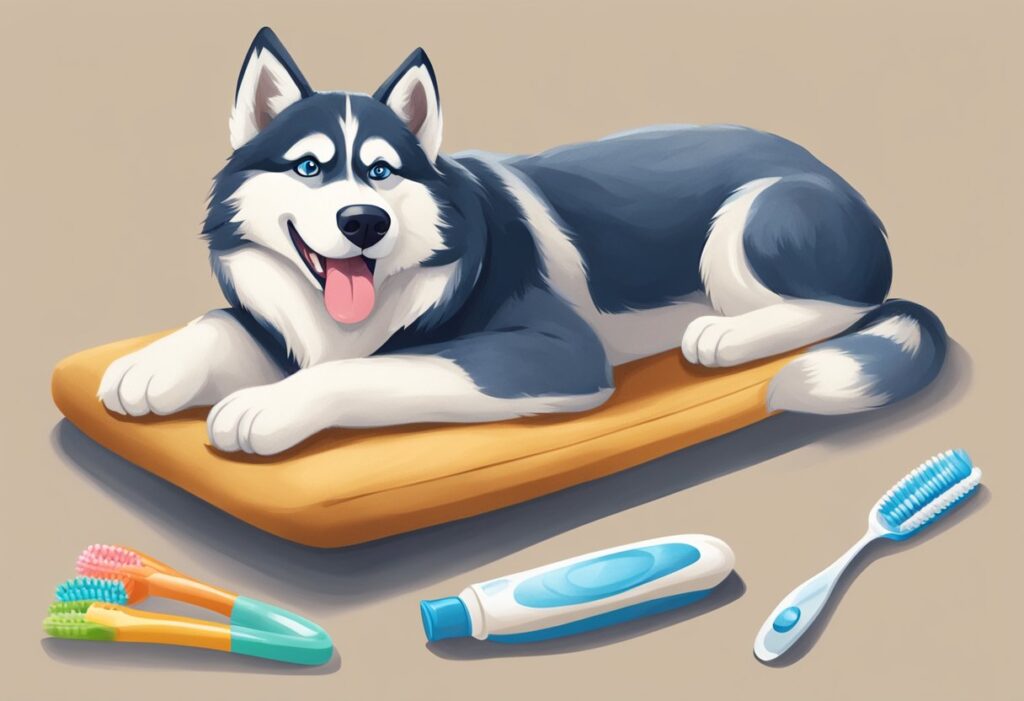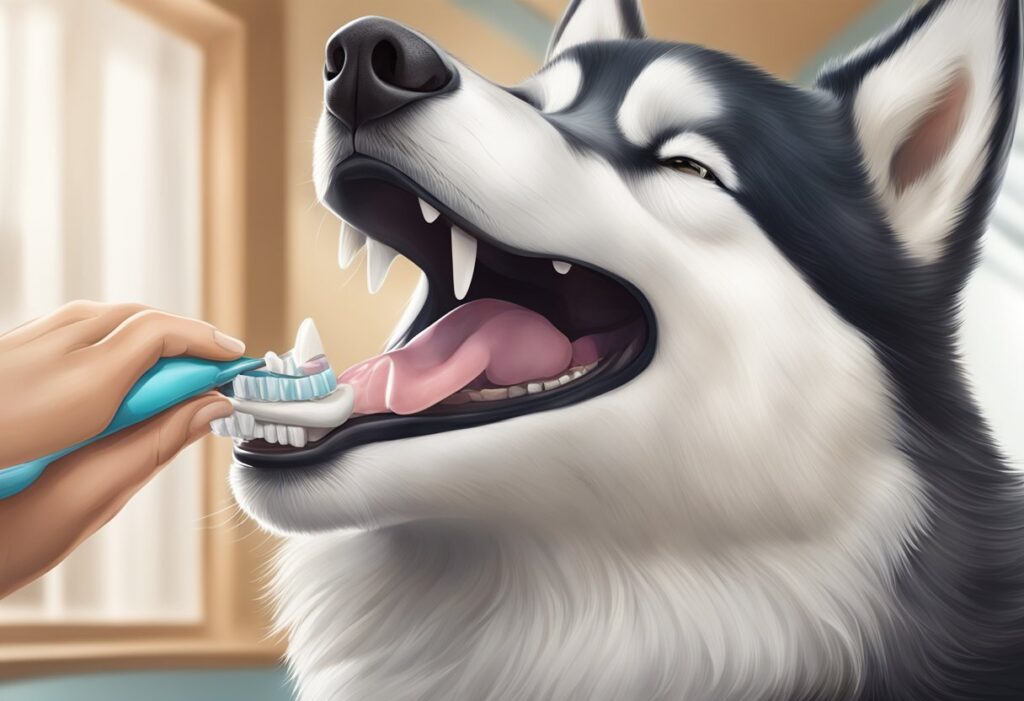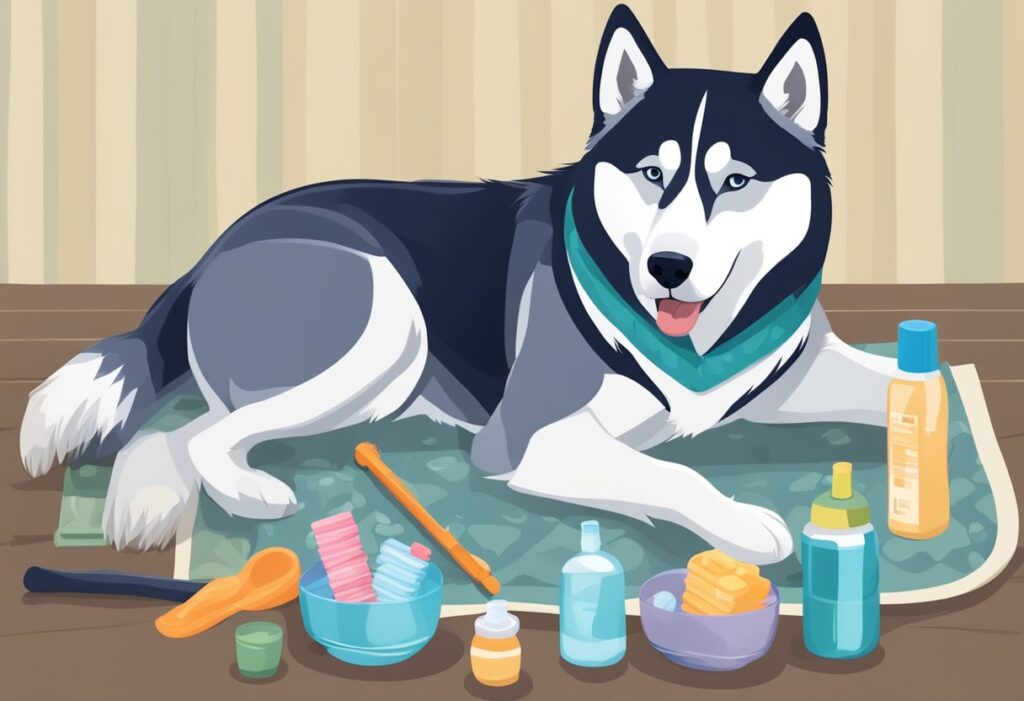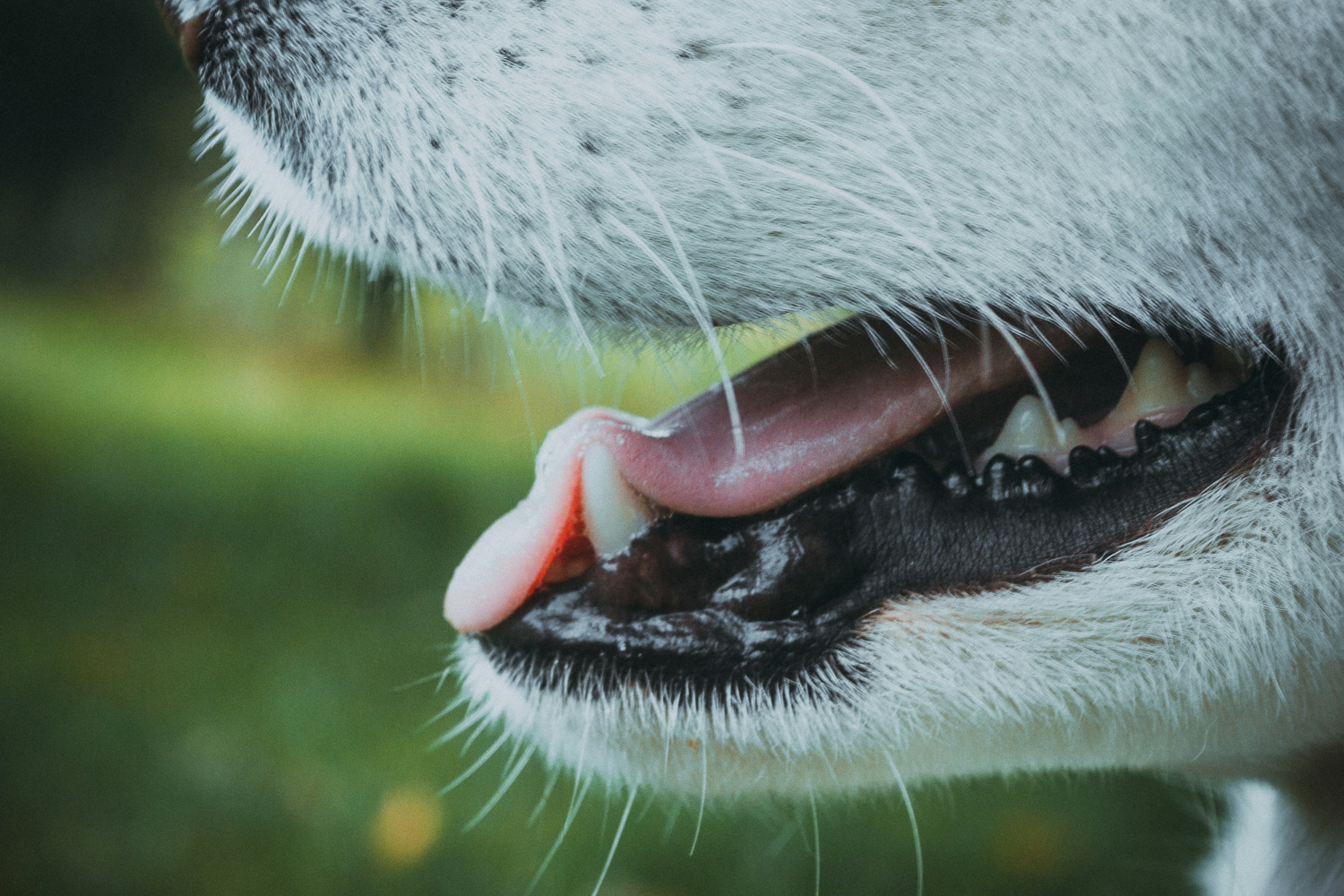Huskies are known for their striking looks and energetic personalities, but their dental health is often overlooked. These dogs need regular dental care to stay happy and healthy. Proper dental hygiene can prevent bad breath, gum disease, and tooth loss in Huskies.

Brushing a Husky’s teeth at least two to three times a week is key to good oral health. This helps remove plaque and tartar buildup. Dental chews and toys can also help clean teeth and massage gums. A diet that includes dry kibble can aid in keeping teeth clean.
Regular check-ups with a vet are important for a Husky’s dental care. Vets can spot early signs of dental problems and do professional cleanings when needed. With good home care and vet visits, Huskies can maintain strong teeth and healthy gums throughout their lives.
Key Takeaways
- Brush Husky teeth 2-3 times weekly to prevent dental issues
- Offer dental chews and toys to help clean teeth and gums
- Schedule regular vet check-ups for professional dental care
Understanding Husky Dental Anatomy

Huskies have 42 adult teeth, just like other dog breeds. Their teeth include incisors, canines, premolars, and molars. Each type of tooth serves a specific purpose in a husky’s mouth.
Incisors are the small teeth at the front of the mouth. Huskies use these for grooming and nibbling. Canines are the long, pointed teeth used for gripping and tearing food.
Premolars and molars make up the back teeth. These larger teeth help huskies grind and chew their food. Premolars are found behind the canines, while molars sit at the very back of the mouth.
Husky teeth are anchored in the jaw by roots. The roots are covered by gums, which protect the sensitive tissues underneath. Healthy gums are pink and firm to the touch.
A husky’s mouth also contains salivary glands. These glands produce saliva, which helps break down food and keep the mouth clean. Saliva plays a key role in maintaining dental health.
Huskies have a double-layered enamel on their teeth. This tough outer coating helps protect against tooth decay. Regular dental care is still important to keep this enamel strong.
Understanding husky dental anatomy is crucial for proper oral care. It helps owners spot problems early and take steps to prevent tooth decay. Regular check-ups with a vet can ensure a husky’s teeth stay healthy throughout their life.
Essential Husky Dental Hygiene Practices
Good dental care is key for Husky health. Regular cleaning, proper brushing, and the right products help keep a Husky’s teeth strong and healthy.
Regular Teeth Cleaning
Huskies need their teeth cleaned often. Owners should clean their Husky’s teeth at least 2-3 times a week. Daily cleaning is even better. This helps stop plaque and tartar buildup.
Dental chews can help clean teeth between brushings. These chews scrape off plaque as the dog chews. But they don’t replace brushing.
Vets should check a Husky’s teeth once a year. They can do a deep clean if needed. This keeps gums healthy and catches any issues early.
Proper Tooth Brushing Techniques
Brushing a Husky’s teeth takes care and patience. Use a soft-bristled toothbrush made for dogs. Put a small amount of dog toothpaste on the brush.
Lift the Husky’s lip gently. Brush in small circles on the outer sides of the teeth. Pay extra attention to the back teeth where plaque often builds up.
Brush for about 30 seconds on each side of the mouth. Reward the Husky after brushing to make it a good experience.
Choosing the Right Dental Products
Pick products made just for dogs. Never use human toothpaste. It can make dogs sick.
Dog toothpaste comes in flavors like chicken or peanut butter. This makes brushing more fun for Huskies.
Look for dental chews with the Veterinary Oral Health Council (VOHC) seal. This means they work well to clean teeth.
Water additives can help fight bacteria in a Husky’s mouth. They’re easy to use but don’t replace brushing.
Preventing Common Dental Issues
Good dental care is key for keeping your husky’s teeth and gums healthy. Regular cleaning and the right products can stop many problems before they start.
Tartar Control Strategies
Tartar builds up on teeth over time. Special chews and toys can help scrape it off. Look for products with the Veterinary Oral Health Council seal. These are proven to work well.
Dental treats are another good option. They have ingredients that fight tartar. Give them to your husky a few times a week. But don’t overdo it – treats should be no more than 10% of their diet.
Regular brushing is the best way to control tartar. Use a dog toothbrush and toothpaste made for pets. Brush your husky’s teeth 2-3 times a week for the best results.
Plaque Removal Techniques
Plaque is a sticky film that forms on teeth. It’s full of bacteria that can harm your husky’s mouth. Removing it often is important.
Brushing is the top way to get rid of plaque. Use circular motions on all tooth surfaces. Pay extra attention to the gum line.
Dental wipes are good for quick cleanings. Rub them on your husky’s teeth and gums. They help wipe away plaque and freshen breath.
Water additives can fight plaque too. Add them to your husky’s water bowl. They work all day to keep teeth clean.
Gum Disease Prevention
Healthy gums are vital for your husky’s mouth. Gum disease can lead to tooth loss and other health issues.
Feed your husky a balanced diet. Good nutrition helps keep gums strong. Look for foods that support dental health.
Check your husky’s mouth often. Look for red, swollen gums or bad breath. These can be early signs of gum problems.
Regular vet checkups are a must. Your vet can spot gum issues early. They may suggest a deep cleaning if needed.
Chew toys help clean gums and strengthen jaw muscles. Pick safe, durable toys made for dogs. Avoid toys that are too hard, as they can crack teeth.
Nutritional Choices and Dental Health
Food and treats play a big role in keeping husky teeth healthy. The right choices can help clean teeth and prevent dental problems.
Selecting Dental-Friendly Treats
Dental chews and treats made for huskies can help clean their teeth. Look for treats with textures that scrape plaque off teeth as the dog chews. Some good options are rawhide chews, dental sticks, and vegetable-based dental chews.
Dry kibble is better for teeth than wet food. The crunchy texture helps scrub teeth clean. Some kibbles are even made specially to clean teeth.
Avoid giving huskies human food or sticky treats. These can get stuck in teeth and cause decay. Instead, try giving raw carrots or apple slices as healthy, teeth-cleaning snacks.
Always check with your vet before changing your husky’s diet. They can suggest the best food and treats for your dog’s dental health.
Professional Dental Care for Huskies
Huskies need regular dental check-ups and cleanings to keep their teeth healthy. Professional care helps prevent serious dental issues and catches problems early.
Choosing a Veterinarian for Dental Services
Look for a vet who specializes in dog dental care. Ask about their experience with huskies. Check if they use modern dental tools and x-ray machines.
Make sure the vet clinic is clean and well-equipped. A good vet will explain the dental procedures clearly. They should be willing to answer all your questions.
Ask about their anesthesia practices. Safe anesthesia is key for dental work on huskies. The vet should do blood tests before using anesthesia.
Understanding Professional Dental Cleaning
A full dental cleaning for huskies takes 1-2 hours. The vet will:
- Remove tartar and plaque
- Polish the teeth
- Take x-rays to check for hidden problems
- Examine the gums for disease
The husky will be under anesthesia during cleaning. This lets the vet work safely and check hard-to-reach spots.
After cleaning, the vet may apply a sealant to protect the teeth. They’ll give you tips for home dental care too. Regular cleanings help keep your husky’s mouth healthy and pain-free.
Home Remedies and Daily Oral Care Tips

Proper dental care is key for keeping your Husky’s teeth and gums healthy. Regular cleaning and good habits can prevent many common oral health issues.
Bad Breath Solutions
Bad breath in Huskies often stems from poor oral hygiene or dental problems. Brushing your Husky’s teeth daily with dog-safe toothpaste is the best way to fight bad breath. You can also try adding parsley or mint to their food as natural breath fresheners.
Dental chews and toys help remove plaque while satisfying your Husky’s urge to chew. Look for products with the Veterinary Oral Health Council (VOHC) seal of approval. A small amount of coconut oil mixed into food may help reduce bacteria that cause bad breath.
Make sure your Husky drinks plenty of fresh water throughout the day. This helps wash away food particles and bacteria in the mouth. If bad breath persists, see your vet to check for underlying dental issues.
Daily Oral Hygiene Tips
Start a tooth brushing routine when your Husky is young. Use a soft-bristled toothbrush and dog toothpaste. Never use human toothpaste, as it can be harmful if swallowed. Brush in gentle circular motions, focusing on the gum line.
Offer dental chews or toys after meals to help clean teeth. Raw carrots or apple slices make great natural “toothbrushes” for Huskies. Always supervise chewing to prevent choking.
Check your Husky’s mouth weekly for signs of dental problems:
- Red or swollen gums
- Loose or discolored teeth
- Excessive drooling
- Difficulty eating
Feed a high-quality diet that supports dental health. Some dog foods are made to help clean teeth as your Husky eats. Ask your vet for recommendations suited to your Husky’s needs.



Leave a Reply